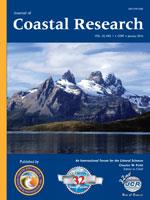Makowski, C.; Finkl, C.W., and Vollmer, H.M., 2016. Classification of continental shelves in terms of geospatially integrated physiographic realms and morphodynamic zones.
The continental shelf off southeast Florida contains a range of benthic environments that are discernible via remote sensing platforms because of low turbidity in the water column. Using the Geospatially Integrated Seafloor Classification Scheme (G-ISCS), physiographic realms and associated morphodynamic zones were cognitively interpreted and classified at a nominal scale of 1:6000 across four remote sensing platforms (i.e. GeoEye IKONOS-2, Landsat-5 Thematic Mapper [TM], Landsat-7 Enhanced Thematic Mapper [ETM], and National Agriculture Imagery Program [NAIP] high-resolution aerial orthoimagery). Attribute tables were created in conjunction with interpretations to quantify and compare spatial relationships between classificatory units and the different remote sensing platforms. Resultant maps exported from ESRI ArcGIS® ArcMap software showed that while IKONOS-2 satellite imagery and NAIP aerial orthoimagery provided the greatest detail, classification of physiographic realms and morphodynamic zones was still possible using TM and ETM satellite images. Overall, it was determined that IKONOS-2 provided the most beneficial imagery when applying such a classification of coastal and seafloor features. It is postulated that accurate delineation of physiographic realms and morphodynamic zones can provide a foundation for more in-depth biogeomorpholocial classification (e.g., further subdivision into benthic geoforms, coastal landforms, biological cover) along continental shelves.





